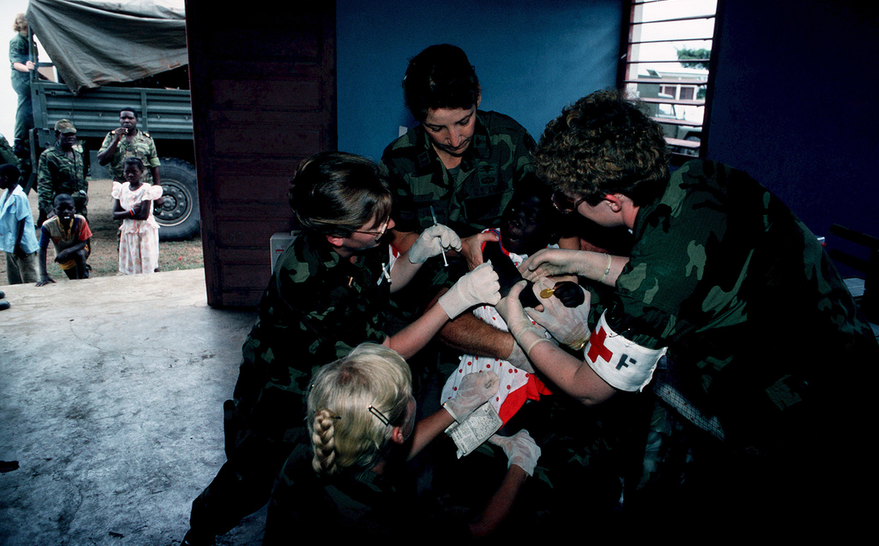The Impact of Conflict on Infectious Disease: A Systematic Literature Review

University of Crete (Marou, Vardavas, Aslanoglou, Nikitara, Plyta); Harvard University (Vardavas); University of Nottingham (Leonardi-Bee, Atkins); European Centre for Disease Prevention and Control (Condell, Lamb, Suk)
"...collaboration between humanitarian and health actors, community engagement, and political will were identified as critical factors in responding to infectious disease outbreaks in conflict settings."
Conflict situations, armed or not, have been associated with emergence and transmission of infectious diseases. For instance, armed conflict in the Northwest region of Cameroon created destructive conditions that exacerbated the COVID-19 pandemic, including the internal population displacement, the destruction of health facilities, the killing of healthcare workers, the disruption of the regional healthcare system, and difficulties in delivering vaccines in security-compromised areas. This systematic review aims to identify the pathways through which infectious diseases emerge within conflict situations and to outline appropriate infectious disease preparedness and response strategies.
A systematic review was performed representing published evidence from January 2000 to October 2023. Ovid Medline and Embase were utilised to obtain literature on infectious diseases in any conflict settings. The systematic review adhered to PRISMA (Preferred Reporting Items for Systematic Reviews and Meta-analysis). No geographical restrictions were imposed.
The review identified 51 studies covering AIDS, Hepatitis B, Tuberculosis, Cholera, Coronavirus 2, Ebola, Poliomyelitis, Malaria, Leishmaniasis, Measles, Diphtheria, Dengue, and Acute Bacterial Meningitis within conflict settings in Europe, Middle East, Asia, and Africa. Key factors contributing to disease emergence and transmission in conflict situations included population displacement, destruction of vital infrastructure, reduction in functioning healthcare systems and healthcare personnel, disruption of disease control programmes (including reduced surveillance, diagnostic delays, and interrupted vaccinations), reduced access by healthcare providers to populations within areas of active conflict, increased population vulnerability due to limited access to healthcare services, and disruptions in the supply chain of safe water, food, and medication.
To mitigate these infectious disease risks, reported preparedness and response strategies included both disease-specific intervention strategies as well as broader concepts such as the education of conflict-affected populations through infectious disease awareness programmes, investing in and enabling health care in locations with displaced populations, intensifying immunisation campaigns, and ensuring political commitment and intersectoral collaborations between governments and international organisations.
For example, in the case of Ebola virus disease (five studies included in the review), the epidemic in the Democratic Republic of Congo (DRC) occurred in the midst of an active armed conflict that led to an increase in transmission that was attributable primarily to the organised attacks by armed groups targeting healthcare providers and Ebola treatment centres and the population's increasing distrust of the response effort, including vaccination, that impeded information-sharing and cooperation. In response, the DRC Ministry of Health collaborated with health workers from non-governmental organisations (NGOs) and United Nations (UN) agencies, and, alongside with the linguistic and cultural awareness of local personnel, implemented strategies such as ring vaccination. Suggested preparation strategies included engaging the community to build trust among residents, ensuring the safety of frontline workers that provide treatment, conducting contact tracing, and distributing vaccines.
One lesson from the review's five studies on poliomyelitis and conflict is that the World Health Organization (WHO), United Nations Children's Fund (UNICEF), and other UN agencies involved in global health should be supported, funded, and allowed to function independently of governments to provide necessary medical and humanitarian relief for civilians. Also, in order to ensure uninterrupted immunisation coverage and thus successful eradication of polio in conflict zones, direct negotiations with anti-government organisations should be conducted.
The paper's discussion section notes that disease education/awareness programmes and community mobilisation/engagement campaigns were considered a necessary part of any plan to successfully prevent epidemics for the majority of the studied infectious diseases. Measures included education and sensitising programmes for infectious diseases geared toward at-risk populations and populations in host communities through culturally appropriate information on symptoms and ways to seek medical advice and treatment. Disease awareness programmes for civilians, and importantly for military personnelm on personal protective measures, immunisations, chemoprophylaxis, and surveillance were suggested. The distribution of public awareness material on proper personal hygiene, food, and water safety for other infectious diseases was also suggested. In the case of HIV infection, the emphasis was placed on educating young people aged 15 to 24 with the development of educational/awareness materials in appropriate languages, programmes for in-school and out-of-school youth, peer education, youth centres, sports/drama groups, and programmes aimed at reducing teenage pregnancy and sexual violence.
Furthermore, the importance of collaborative efforts between international agencies and nongovernmental organisations, national and regional authorities, and local/front-line NGOs was stressed in most of the studied articles. During active conflicts, interoperability and biosurveillance information sharing across agencies are needed. In addition, political commitment is necessary to achieve, as far as possible, uninterrupted and safe medical and humanitarian aid to conflict zones, as well as support for post-conflict recovery.
In conclusion: "Conflict plays a direct and indirect role in the transmission and propagation of infectious diseases. The findings from this review can assist decision-makers in the development of evidence-based preparedness and response strategies for the timely and effective containment of infectious disease outbreaks in conflict zones and amongst conflict-driven displaced populations."
Conflict and Health (2024) 18:27. https://doi.org/10.1186/s13031-023-00568-z. Image caption/credit: Army personnel from the 97th General Hospital hold down a child in order to give her an immunisation. Villagers were immunised against mumps, polio, measles, rubella, yellow fever, and typhoid during Gabon Medflag 88. Sgt Paul A. Tubr via picryl (Public Domain)
- Log in to post comments
